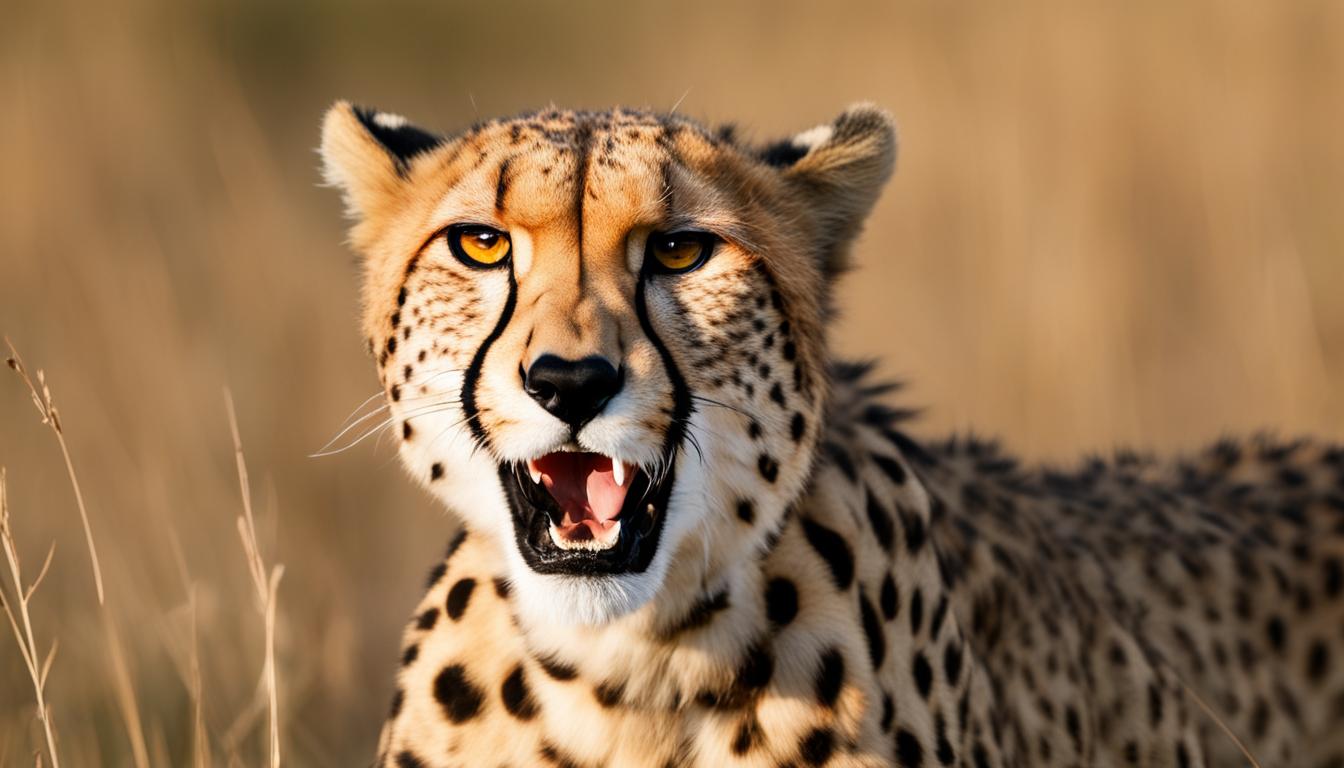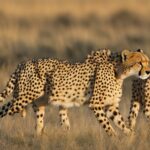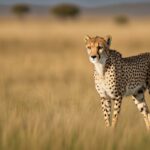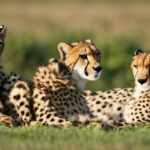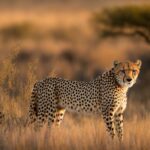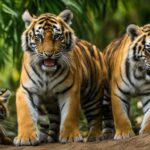Cheetahs are known for their incredible speed and agility, but did you know that they also have a diverse vocal repertoire? Vocalizations play a crucial role in cheetah communication, allowing them to express their needs, emotions, and alerts in the wild. In this article, we will explore the fascinating world of cheetah vocal behavior, from the different sounds they produce to the research findings on their vocalizations. Strap in and get ready to discover the unique vocal patterns and repertoire of cheetahs.
Types of Cheetah Vocalizations
Cheetahs are known for their diverse vocal repertoire, using a variety of sounds to communicate with each other and express different needs and emotions. These vocalizations can be categorized into three main types: pulsed sounds, tonal sounds, and noisy sounds.
Pulsed sounds are characterized by short, repeated bursts of sound and include vocalizations such as “chirrs,” “pr-prs,” “gargles,” “churtlings,” “gurgling,” “purring,” and “growling.” These sounds are often used during social interactions and can convey feelings of excitement or aggression.
Tonal sounds, on the other hand, are characterized by longer, sustained tones. They include vocalizations such as “chirping,” “howling,” and “yelping.” These tonal sounds are often used for long-distance communication and can serve as calls for assistance or warnings to other cheetahs in the area.
Noisy sounds, as the name suggests, are characterized by sharp, abrupt noises. The most common noisy sound produced by cheetahs is a “hiss.” This vocalization is often associated with defensive behavior and is used to intimidate or ward off potential threats.
By utilizing these different types of vocalizations, cheetahs are able to effectively communicate with each other and navigate their social interactions in the wild.
Table: Types of Cheetah Vocalizations
| Pulsed Sounds | Tonal Sounds | Noisy Sounds |
|---|---|---|
| Chirrs | Chirping | Hissing |
| Pr-prs | Howling | |
| Gargles | Yelping | |
| Churtlings | ||
| Gurgling | ||
| Purring | ||
| Growling |
Cheetah Vocalizations and Research Findings
Researchers have been conducting studies on cheetah vocalizations to gain a deeper understanding of their communication behaviors. A comprehensive study found that cheetahs produce a wide range of vocalizations, including 16 different types of sounds such as mews, growls, sneezes, meows, purrs, hisses, and more. These vocalizations were observed and recorded in both hand-reared captive cheetahs and wild-born adults. The study revealed that early-reared cheetahs vocalized less and had a less varied repertoire compared to late-reared cheetahs.
Another research project focused on the vocalizations of cheetahs in the wild. It found that cheetahs use vocalizations for a variety of purposes, including communication with other cheetahs, marking their territory, and attracting mates. These vocalizations play a crucial role in their social interactions and survival strategies.
While significant progress has been made in understanding cheetah vocalizations, there is still much more to uncover. Future research endeavors aim to explore the reasons behind the differences in vocal repertoire between early and late-reared cheetahs, as well as the specific roles of vocalizations in various social interactions. By delving deeper into the world of cheetah vocalizations, researchers hope to contribute to the conservation efforts of this magnificent species.
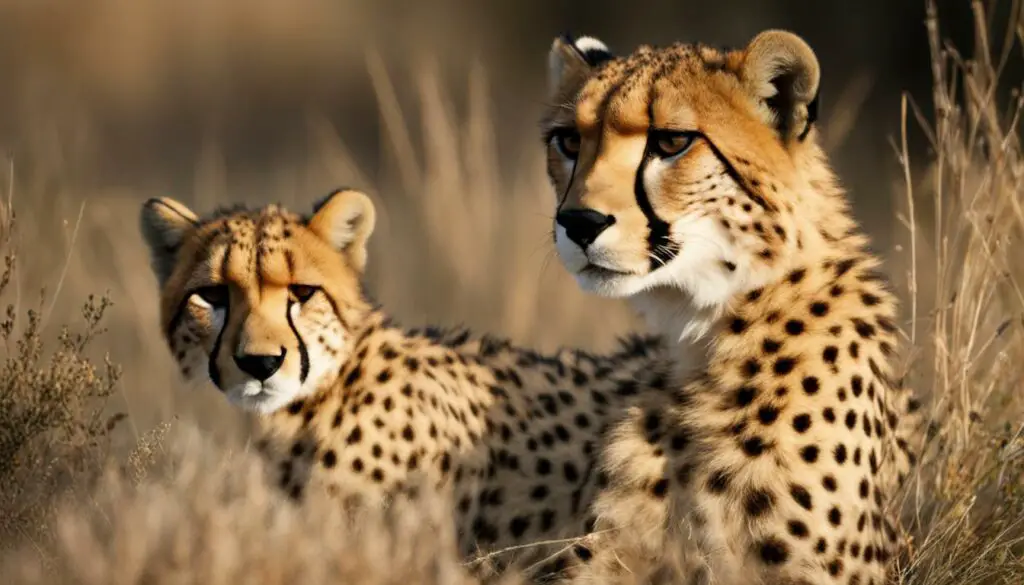
The Importance of Maternal Deprivation on Vocalizations
Maternal deprivation has a significant impact on the vocalizations of cheetahs. When cheetahs are hand-reared during the early stages of life due to human-wildlife conflict or rescue from the illegal pet trade, they display fewer vocalizations and a less diverse repertoire compared to those raised by their mothers. This deprivation of maternal care and socialization during crucial developmental periods results in limited exposure to natural vocal patterns and communication cues.
A study conducted on cheetahs revealed that females reared early in life also exhibited a less varied vocal repertoire compared to other individuals, while males displayed a greater diversity of calling patterns. This gender-based difference suggests that the rearing history of cheetahs and their gender can influence the use of vocal repertoire. Understanding the impact of maternal deprivation on vocalizations is crucial for conservation efforts and developing effective strategies to mitigate the consequences of human-wildlife conflict.
Maternal care plays a vital role in the development of vocal communication skills in cheetahs. Cubs learn important vocalizations from their mothers and siblings during the early stages of life. Through vocalizations, cheetah cubs establish social bonds, convey needs, and learn crucial hunting and survival skills. Maternal deprivation disrupts this natural process, leading to a reduced vocal repertoire and potentially impacting their ability to communicate effectively in the wild.
“The impact of maternal deprivation on cheetah vocalizations highlights the importance of understanding an individual’s background when studying cheetah vocal behavior. By considering the early rearing experiences and gender of cheetahs, researchers can gain a deeper insight into the complexities of their vocal repertoire and the effects of human intervention.”
| Effects of Maternal Deprivation on Cheetah Vocalizations | Differences Based on Gender |
|---|---|
| Cheetahs hand-reared during early stages display fewer vocalizations | Females reared early exhibit a less varied vocal repertoire |
| Reduced diversity of vocal repertoire | Males raised early show a greater diversity of calling patterns |
| Disrupted socialization and limited exposure to natural vocal patterns |
Vocalizations in the Life Cycle of a Cheetah
The vocalizations of cheetahs play a crucial role throughout their life cycle, starting from the cub stage. During this stage, cheetah cubs rely on vocalizations to communicate with their mother and siblings. It is through vocalizations that they learn important hunting and survival skills, as well as develop social bonds within their family unit.
In the adolescence stage, vocalizations continue to be an essential means of communication for cheetahs. During this time, they interact with other cheetahs and learn from their experiences. Vocalizations help them establish social hierarchies, recognize individuals, and coordinate group hunting strategies.
As cheetahs enter adulthood, vocalizations remain an important aspect of their lives. They use their vocal repertoire to communicate during territorial disputes, mating rituals, and to establish dominance. These vocalizations convey vital information to other cheetahs in their vicinity, ensuring effective communication in their habitat.
The Role of Vocalizations in Cheetah Life Cycle
Vocalizations are not only a form of communication for cheetahs but also play a critical role in their survival and well-being. It is through vocalizations that they establish and maintain social bonds, learn important skills, and navigate their environment. Understanding the significance of vocalizations in the life cycle of a cheetah provides valuable insights into their behavior and aids in conservation efforts.
| Vocalizations in Cheetah Life Cycle | |
|---|---|
| Cub Stage | Vocalizations are crucial for communication with the mother and siblings, learning hunting skills, and social bonding. |
| Adolescence | Vocalizations aid in social interactions, learning from other cheetahs, and establishing social hierarchies. |
| Adulthood | Vocalizations are used for territorial disputes, mating rituals, and establishing dominance within the cheetah population. |
“The vocal repertoire of cheetahs serves as a vital means of communication throughout their life cycle, facilitating social interactions, learning, and survival strategies.”
Physical Characteristics and Markings of a Cheetah
Cheetahs possess unique physical characteristics and markings that contribute to their remarkable appearance and communication. These features are essential for their survival and camouflage in the wild. Let’s explore the distinct qualities that make cheetahs stand out.
The cheetah’s physical structure is designed for speed and agility. They have a slim frame with a narrow waist and a deep chest, allowing for increased oxygen intake during high-speed chases. Their long legs and flexible spine provide them with a wide stride and excellent maneuverability, enabling quick turns and sudden bursts of acceleration. Cheetahs also have semi-retractable claws that provide traction while running and help maintain stability during rapid movements.
One of the most recognizable physical characteristics of a cheetah is its coat. Their undercoat ranges from light tan to deep gold, allowing them to blend into the grassy savannahs where they predominantly reside. The coat is adorned with solid black spots, which act as natural camouflage, breaking up their silhouette and making them less conspicuous to their prey. Additionally, cheetahs have tear stripes that run from the inner corner of their eyes to the sides of their mouths. These black tear stripes help protect their eyes from the sun’s glare and may also enhance their facial expressions during communication.
“The cheetah’s physical characteristics, such as its slim build, long legs, and tear stripes, all play a crucial role in its survival and communication in the wild.”
– Wildlife Expert
| Physical Characteristics | Markings |
|---|---|
| Slim frame | Light tan to deep gold undercoat |
| Narrow waist | Solid black spots |
| Deep chest | Tear stripes |
| Long legs | |
| Flexible spine |
The markings and physical characteristics of a cheetah work together not only for their survival but also for communication within their species. By understanding these unique features, we can gain a deeper appreciation for cheetahs and their incredible adaptations.
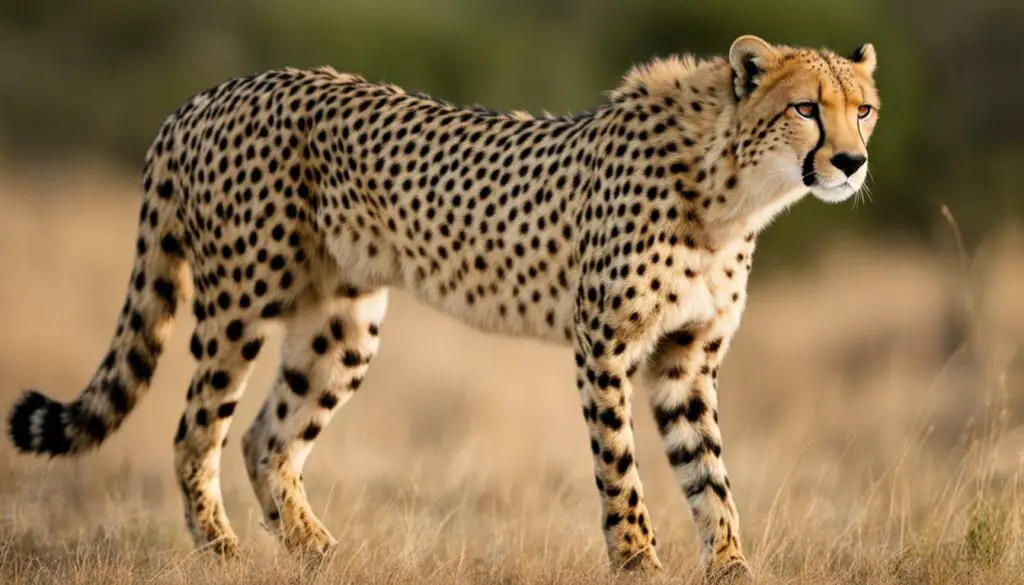
Adaptations for Speed and Hunting
As the fastest land animal, cheetahs possess a range of physical adaptations that enable their impressive hunting abilities. Their lithe and slender bodies are built for speed, with a flexible spine and lightweight frame that minimizes drag as they sprint across the savannah. Cheetahs also have long legs and a long tail, providing them with excellent balance and stability during high-speed pursuits. These adaptations allow them to chase down their prey with incredible precision and agility.
In addition to their physical attributes, cheetahs have unique hunting strategies and vocal communication that further enhance their hunting success. When hunting in a group, cheetahs use subtle vocalizations to coordinate their movements and maintain communication. These vocal cues help them work together effectively, increasing their chances of a successful hunt. By utilizing their vocalizations in this way, cheetahs demonstrate the importance of communication in their hunting strategies.
Furthermore, cheetahs’ adaptations extend to their claws and foot pads. Unlike other big cats, cheetahs have semi-retractable claws that provide them with additional traction and grip while running at high speeds. Their foot pads are also hard and durable, offering stability and minimizing slipping during rapid acceleration and sudden changes in direction. These adaptations allow cheetahs to maintain their speed and agility while pursuing prey, ensuring a successful hunt.
Overall, the combination of physical adaptations, vocal communication, and hunting strategies makes cheetahs highly specialized predators. Their streamlined bodies, long limbs, and unique vocalizations all contribute to their exceptional speed and hunting capabilities. By studying and appreciating these adaptations, we gain a deeper understanding of the remarkable nature of cheetahs and their ability to thrive as apex predators in their habitats.
Table: Adaptations for Speed and Hunting in Cheetahs
| Adaptation | Description |
|---|---|
| Flexible Spine | Enables the cheetah to stretch its body fully while running, maximizing stride length and speed. |
| Long Legs | Provide a longer stride and faster acceleration, essential for chasing down prey. |
| Long Tail | Acts as a counterbalance, providing stability and aiding in sharp turns and sudden changes in direction. |
| Semi-retractable Claws | Offer increased traction and grip during high-speed chases, aiding in maintaining stability and control. |
| Hard Foot Pads | Provide stability and minimize slipping, allowing cheetahs to maintain momentum during hunts. |
Conclusion
Cheetahs have a diverse vocal repertoire that includes growls, purrs, chirps, and other unique vocalizations. These vocalizations play a crucial role in communication, social interactions, and hunting throughout a cheetah’s life. From the cub stage to adulthood, cheetahs rely on vocalizations to express their needs, emotions, and alerts.
Early rearing experiences and gender can influence the diversity and use of a cheetah’s vocal repertoire. Maternal deprivation, caused by human-wildlife conflict or rescue from the illegal pet trade, can have lasting impacts on their vocalizations. Understanding the background and rearing history of cheetahs is essential when studying their vocal behavior.
Studying and appreciating cheetah vocalizations provide insight into the fascinating world of these swift predators. By delving into the intricacies of their vocal repertoire, we can contribute to the conservation efforts aimed at protecting cheetahs and their habitats. Further research is needed to fully comprehend the role of vocalizations in cheetah social interactions and their significance in the wild.
What specific sounds do cheetahs use to communicate in the wild?
Cheetah communication in the wild involves various sounds like purring, chirping, growling, and hissing. They use these sounds to communicate with their young, warn others of danger, or establish their territory. These vocalizations play a crucial role in the social dynamics and survival of cheetahs in their natural habitat.
FAQ
What types of vocalizations do cheetahs produce?
Cheetahs produce a variety of sounds including growls, purrs, chirps, and an “explosive yelp” that can be heard from a distance of 2 km. They also produce moans, hisses, and spitting vocalizations during agonistic situations.
How can cheetah vocalizations be categorized?
Cheetah vocalizations can be categorized into pulsed sounds, tonal sounds, and noisy sounds. Pulsed sounds include “chirrs,” “pr-prs,” “gargles,” “churtlings,” “gurgling,” “purring,” and “growling.” Tonal sounds include “chirping,” “howling,” and “yelping.” Noisy sounds include “hissing.”
Are cheetahs capable of roaring like other big cats?
No, cheetahs belong to the “purring cats” subfamily and do not roar. They communicate through various vocalizations, including purrs, growls, chirps, and other unique sounds.
How do early rearing experiences influence cheetah vocalizations?
Early rearing experiences can influence the diversity of a cheetah’s vocal repertoire. Cheetahs hand-reared during early stages of life display fewer vocalizations and a less diverse repertoire compared to those raised by their mothers. Maternal deprivation caused by human-wildlife conflict or rescue from the illegal pet trade can have lasting impacts on their vocalizations.
How do cheetahs use vocalizations throughout their life cycle?
Cheetahs rely on vocalizations to communicate with their mother and siblings during the cub stage. Vocalizations continue to play a role in social interactions and learning from other cheetahs during adolescence. As adults, cheetahs use vocalizations for communication, particularly during mating and territorial marking.
What are the physical characteristics and markings of a cheetah?
Cheetahs have a thin frame with a narrow waist and deep chest. Their undercoat ranges from light tan to deep gold and is marked by solid black spots. They have tear stripes running from their eyes to their mouth, a bushy tuft at the end of their tail, and foot pads with short blunt claws for improved traction and grip during high-speed chases.
How are cheetahs adapted for speed and hunting?
Cheetahs’ unique body structure, including a flexible spine, semi-retractable claws, long legs, and a long tail, allows them to achieve incredible speeds. Their physical adaptations, combined with their vocalizations and communication, make them formidable hunters in the wild.

